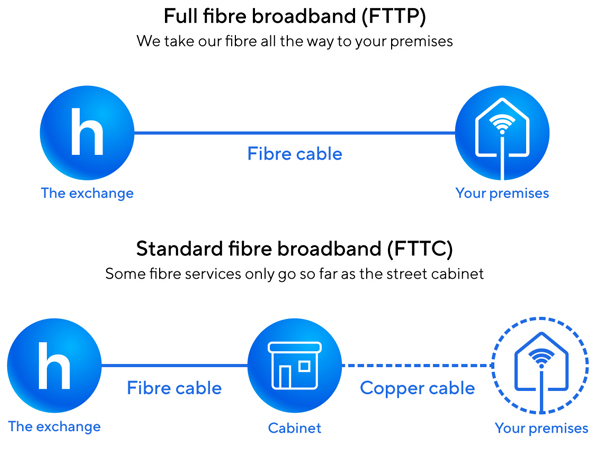FTTP Explained |

You might have heard the terms Fibre to the Premises (FTTP) or Fibre to the Building (FTTB) cropping up a lot more recently. That’s because it’s the fastest, latest, and most reliable broadband connection currently available, and it’s slowly making its way throughout the country.
With its lightning-fast speeds and unparalleled reliability, FTTP is paving the way for a new era of digital connectivity. Gone are the days of frustratingly slow downloads and laggy online experiences; FTTP is here to deliver seamless browsing, smooth video streaming, and lag-free online gaming.
Since FTTP brings optical fibre directly to your premises or building, it bypasses the limitations of traditional copper or coaxial cables used in traditional Fibre to the Cabinet (FTTC) broadband. Below we answer questions like “What is FTTP broadband” and dive into how it works, its benefits, and how you can switch over today.
What is FTTP?
FTTP is a type of broadband connection that delivers internet services directly to a user’s home or premises using fibre optic cables. These cables are laid from the broadband exchange to your home without interruption, meaning there is no connection or additional line they need to go through to provide internet connectivity.
Unlike traditional copper-based connections like Asymmetric Digital Subscriber Lines (ADSL), FTTP fibre broadband utilizes glass cables that can transmit data at a speed of around two-thirds of the speed of light.
This technology ensures ultrafast internet speeds and significantly lowers latency, resulting in an optimal online experience. Because of this, FTTP enables 4k streaming, video calling, and downloads on multiple devices at once.
FTTP provides several other benefits, including:
- Ultra-Fast Internet Speeds: FTTP broadband speed is a major draw for users who require quick downloads, seamless streaming, and rapid online activities.
- Reliability: FTTP ensures a stable internet connection with minimal disruptions, crucial for businesses and households that rely heavily on uninterrupted connectivity.
- Symmetrical Upload and Download Speed capabilities: The symmetrical capabilities of FTTP (equal upload and download speeds) is particularly valuable for businesses and content creators who need efficient and fast upload capabilities.
- Enhanced User Experience: FTTP broadband significantly improves the overall online experience, making activities like streaming, online gaming, and video conferencing smoother and more enjoyable.
- Digital Equity: The expansion of FTTP networks helps reduce the digital divide by providing high-speed internet access to underserved and rural areas, promoting equal opportunities for getting online.
How can I get fibre to the premises?
Before you can get fibre optic broadband installed, there are several important steps to consider.
- Check Availability: Start by checking with your ISP or telecommunication company to determine if FTTP broadband is available in your area. Many ISPs are actively expanding their fibre networks, so even if it’s not currently available, it might be in the near future.
- Contact ISPs: Reach out to the ISPs that offer FTTP in your area to explore their plans and packages. Compare the services, speeds, and pricing to find the best fit for your needs.
- Installation Process: Once you choose an ISP and FTTP plan, they will guide you through the installation process. Typically, a technician will visit your premises to install the necessary fibre optic cables and set up the FTTP connection.
- Fibre Termination Point (FTP): During the installation, a fibre termination point (FTP) will be installed on your premises. This is where the fibre optic cable connects to your home or business’s internal network.
- Router and Modem: In most cases, the ISP will provide a router and modem that is compatible with FTTP. This equipment will be crucial for establishing the connection and distributing the internet signal within your premises.
Since the availability of fibre optic broadband is still expanding, it’s essential to find out when and where your internet service provider (ISP) plans to roll it out. If your location isn’t ready for it yet, rest assured that it’s likely to be available down the line.
Staying informed about the rollout schedule can help you prepare and take advantage of this cutting-edge technology when it becomes accessible in your area.
Hyperoptic also offers the Switch Now deal, where you can see out your contract with your current ISP while gaining the benefits of Hyperoptic’s ultrafast broadband for free. If you’re still using FTTC broadband and your ISP has no plans to offer FTTP any time soon, then it’s worth checking if Hyperoptic is available in your area.
FTTP vs FTTC
While FTTP broadband and FTTC broadband use fibre optic cables, the key difference lies in how close the fibre connection is to your premises. In FTTC, the fibre optic cables run from the broadband exchange to a street cabinet. From there, the connection is completed using traditional copper cables to your home or business. In contrast, FTTP delivers fibre optic cables directly to your premises.
The main advantage of FTTP over FTTC is that FTTP eliminates the reliance on copper cables for the final connection, resulting in faster and more consistent speeds. Crucially, with FTTC, the broadband speed may decrease the further you are from the street cabinet, which can affect performance.

FTTP vs Other Broadband Connections
| FTTP | FTTC | ADSL | |
|---|---|---|---|
| Speed | Ultrafast | Fast | Slow |
| Upload Speed | Symmetrical (equal download/upload speeds) | Asymmetrical (different download/upload speeds) | Asymmetrical |
| Latency | Low | Moderate | High |
| Stability | Highly stable | Moderately stable | Less stable, prone to drops |
| Future-proof | Yes | Moderate | No |
| Interference | Resistant | Moderate | Susceptible |
| Availability | Limited (expanding) | Widespread | Widespread |
What is the difference between FTTP and Full Fibre?
Fibre broadband, as a whole, is the best form of broadband available and much faster than traditional ADSL. However, not all fibre optic services are created equal. As we have mentioned previously, some services labelled as Fibre optic broadband are just FTTC. This means they are unable to offer the fastest speed because they rely on old copper cables to reach your home.
Full fibre and FTTP/FTTB are essentially the same – we use the phrase “full fibre” so you know you’re getting fibre to your home, rather than to a nearby street cabinet. This ensures a faster, more reliable connection.
Discovering if your home is ready for ultrafast full fibre broadband is as simple as using our broadband coverage map. When you’ve confirmed the availability in your area, it’s just a matter of exploring our broadband deals and price plans to find one right for you. With that, you’ll be all set to enjoy the benefits of full fibre internet.
Frequently Asked Questions about FTTP
FTTP vs FTTH
FTTP (fibre-to-the-premises) and FTTH (fibre-to-the-home) are both terms used to describe broadband delivered using fibre optic cables.
FTTP is when the fibre is brought all the way to the premise (as opposed to stopping at the street cabinet, which is known as FTTC or fibre-to-the-cabinet).
FTTH is actually a type of FTTP, where the fibre is brought all the way to a residential home. Likewise, FTTB (fibre-to-the-building), is also a type of FTTP, where the fibre is brought to the building (for example, a block of flats or an office building).
So FTTP and FTTH are extremely similar. It’s just that FTTH refers to residential homes, whereas FTTP is more broad as it can refer to larger buildings or businesses.
What does FTTP mean?
FTTP broadband, or Fibre to the Premises broadband, differs from FTTC in that it bypasses the street cabinet and connects directly to your home from the broadband exchange. This means it does not use copper cables at any point along its journey, ensuring fast and reliable broadband and internet connectivity. Instead, Fibre broadband uses glass cables to transmit data in the form of light signals, making it incredibly quick and reliable.



